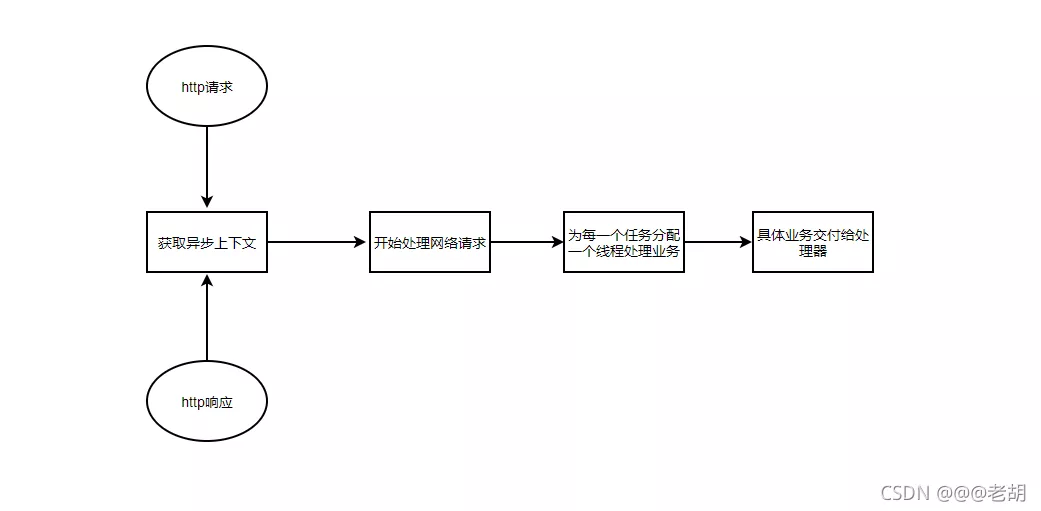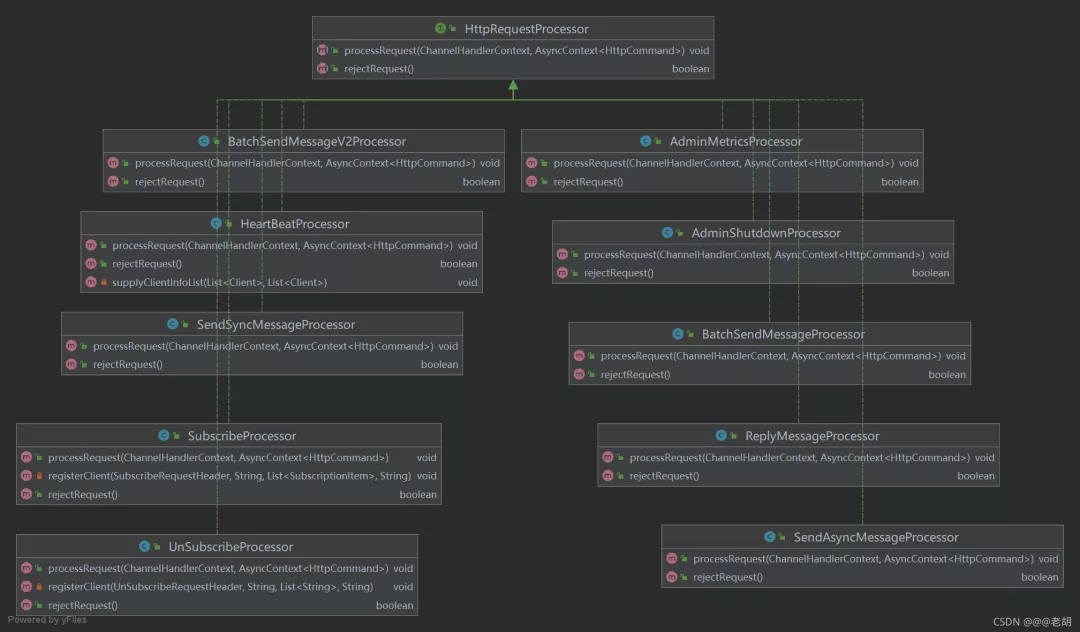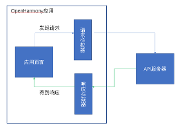EventMesh源码手撕系列(二)之HTTP处理器
源码解析
上一篇Http Server实现中讲到,当channel被注册之后,这个类中的initChannel方法就会被调用,同时在管道后面加入handlers。那具体的,我们的Http Server是怎样处理消息的?
【源代码片段】
class HttpsServerInitializer extends ChannelInitializer<SocketChannel> {...// 在管道后面加入handlerspipeline.addLast(new HttpRequestDecoder(),// 这个是对http解码new HttpResponseEncoder(),// 这个是对http的响应编码new HttpConnectionHandler(),// 这个是对http连接处理new HttpObjectAggregator(Integer.MAX_VALUE),// 这个是http对象聚合new HTTPHandler());// 这个是http的Handler的具体实现}}}
处理逻辑

【源代码片段】
class HTTPHandler extends SimpleChannelInboundHandler<HttpRequest> {@Overrideprotected void channelRead0(ChannelHandlerContext ctx, HttpRequest httpRequest) throws Exception {HttpPostRequestDecoder decoder = null;// todo start server span, we should get channel here to put span in channel's context in async call.try {if (!httpRequest.decoderResult().isSuccess()) {sendError(ctx, HttpResponseStatus.BAD_REQUEST);return;}// 请求命令final HttpCommand requestCommand = new HttpCommand();// todo record command opaque in span.httpRequest.headers().set(ProtocolKey.ClientInstanceKey.IP, RemotingHelper.parseChannelRemoteAddr(ctx.channel()));...Map<String, Object> bodyMap = new HashMap<>();// GET请求if (httpRequest.method() == HttpMethod.GET) {QueryStringDecoder getDecoder = new QueryStringDecoder(httpRequest.uri());getDecoder.parameters().entrySet().forEach(entry -> {bodyMap.put(entry.getKey(), entry.getValue().get(0));});// POST请求} else if (httpRequest.method() == HttpMethod.POST) {decoder = new HttpPostRequestDecoder(defaultHttpDataFactory, httpRequest);// 获取参数列表List<InterfaceHttpData> parmList = decoder.getBodyHttpDatas();for (InterfaceHttpData parm : parmList) {if (parm.getHttpDataType() == InterfaceHttpData.HttpDataType.Attribute) {Attribute data = (Attribute) parm;bodyMap.put(data.getName(), data.getValue());}}} else {sendError(ctx, HttpResponseStatus.METHOD_NOT_ALLOWED);return;}...String requestCode =(httpRequest.method() == HttpMethod.POST) ? StringUtils.deleteWhitespace(httpRequest.headers().get(ProtocolKey.REQUEST_CODE)): MapUtils.getString(bodyMap, StringUtils.lowerCase(ProtocolKey.REQUEST_CODE), "");requestCommand.setHttpMethod(httpRequest.method().name());requestCommand.setHttpVersion(httpRequest.protocolVersion().protocolName());requestCommand.setRequestCode(requestCode);// todo record command method, version and requestCode in span.// 响应命令HttpCommand responseCommand = null;...try {// requestCommand头部和主体requestCommand.setHeader(Header.buildHeader(requestCode, parseHTTPHeader(httpRequest)));requestCommand.setBody(Body.buildBody(requestCode, bodyMap));} catch (Exception e) {responseCommand = requestCommand.createHttpCommandResponse(EventMeshRetCode.EVENTMESH_RUNTIME_ERR.getRetCode(), EventMeshRetCode.EVENTMESH_RUNTIME_ERR.getErrMsg() + EventMeshUtil.stackTrace(e, 3));sendResponse(ctx, responseCommand.httpResponse());return;}...// 异步消息上下文AsyncContext<HttpCommand> asyncContext = new AsyncContext<HttpCommand>(requestCommand, responseCommand, asyncContextCompleteHandler);// 处理网络请求processEventMeshRequest(ctx, asyncContext);} catch (Exception ex) {httpServerLogger.error("AbrstractHTTPServer.HTTPHandler.channelRead0 err", ex);// todo span end with exception.} finally {try {decoder.destroy();} catch (Exception e) {}}}// 处理网络请求public void processEventMeshRequest(final ChannelHandlerContext ctx,final AsyncContext<HttpCommand> asyncContext) {final Pair<HttpRequestProcessor, ThreadPoolExecutor> choosed = processorTable.get(Integer.valueOf(asyncContext.getRequest().getRequestCode()));try {// 为任务分配一个线程choosed.getObject2().submit(() -> {try {// 拒绝请求if (choosed.getObject1().rejectRequest()) {HttpCommand responseCommand = asyncContext.getRequest().createHttpCommandResponse(EventMeshRetCode.EVENTMESH_REJECT_BY_PROCESSOR_ERROR.getRetCode(), EventMeshRetCode.EVENTMESH_REJECT_BY_PROCESSOR_ERROR.getErrMsg());asyncContext.onComplete(responseCommand);if (asyncContext.isComplete()) {if (httpLogger.isDebugEnabled()) {httpLogger.debug("{}", asyncContext.getResponse());}sendResponse(ctx, responseCommand.httpResponse());}return;}// 处理请求,对接到http的协议部分的处理器choosed.getObject1().processRequest(ctx, asyncContext);if (asyncContext == null || !asyncContext.isComplete()) {return;}...// 发送响应sendResponse(ctx, asyncContext.getResponse().httpResponse());} catch (Exception e) {httpServerLogger.error("process error", e);}});} catch (RejectedExecutionException re) {...try {sendResponse(ctx, asyncContext.getResponse().httpResponse());} catch (Exception e) {}}}...}
处理器
每一个处理器都会继承它的父类HttpRequestProcessor,并且重写处理请求和拒绝请求两个方法。具体业务中,会根据消息的请求码分配处理器来对消息进行处理。

处理器逻辑,这里以SendAsyncMessageProcessor消息处理为例进行讲解,其他处理器参照即可。

public class SendAsyncMessageProcessor implements HttpRequestProcessor {@Overridepublic void processRequest(ChannelHandlerContext ctx, AsyncContext<HttpCommand> asyncContext) throws Exception {...// 获取发送消息的请求SendMessageRequestHeader sendMessageRequestHeader = (SendMessageRequestHeader) asyncContext.getRequest().getHeader();SendMessageRequestBody sendMessageRequestBody = (SendMessageRequestBody) asyncContext.getRequest().getBody();// 获取发送消息的响应SendMessageResponseHeader sendMessageResponseHeader =SendMessageResponseHeader.buildHeader(Integer.valueOf(asyncContext.getRequest().getRequestCode()), eventMeshHTTPServer.getEventMeshHttpConfiguration().eventMeshCluster,IPUtil.getLocalAddress(), eventMeshHTTPServer.getEventMeshHttpConfiguration().eventMeshEnv,eventMeshHTTPServer.getEventMeshHttpConfiguration().eventMeshIDC);//证实请求头部if (StringUtils.isBlank(sendMessageRequestHeader.getIdc())|| StringUtils.isBlank(sendMessageRequestHeader.getPid())|| !StringUtils.isNumeric(sendMessageRequestHeader.getPid())|| StringUtils.isBlank(sendMessageRequestHeader.getSys())) {responseEventMeshCommand = asyncContext.getRequest().createHttpCommandResponse(sendMessageResponseHeader,SendMessageResponseBody.buildBody(EventMeshRetCode.EVENTMESH_PROTOCOL_HEADER_ERR.getRetCode(), EventMeshRetCode.EVENTMESH_PROTOCOL_HEADER_ERR.getErrMsg()));asyncContext.onComplete(responseEventMeshCommand);return;}//证实请求主体if (StringUtils.isBlank(sendMessageRequestBody.getBizSeqNo())|| StringUtils.isBlank(sendMessageRequestBody.getUniqueId())|| StringUtils.isBlank(sendMessageRequestBody.getProducerGroup())|| StringUtils.isBlank(sendMessageRequestBody.getTopic())|| StringUtils.isBlank(sendMessageRequestBody.getContent())|| (StringUtils.isBlank(sendMessageRequestBody.getTtl()))) {//sync message TTL can't be emptyresponseEventMeshCommand = asyncContext.getRequest().createHttpCommandResponse(sendMessageResponseHeader,SendMessageResponseBody.buildBody(EventMeshRetCode.EVENTMESH_PROTOCOL_BODY_ERR.getRetCode(), EventMeshRetCode.EVENTMESH_PROTOCOL_BODY_ERR.getErrMsg()));asyncContext.onComplete(responseEventMeshCommand);return;}//检查aclif(eventMeshHTTPServer.getEventMeshHttpConfiguration().eventMeshServerSecurityEnable) {String remoteAddr = RemotingHelper.parseChannelRemoteAddr(ctx.channel());String user = sendMessageRequestHeader.getUsername();String pass = sendMessageRequestHeader.getPasswd();String subsystem = sendMessageRequestHeader.getSys();int requestCode = Integer.valueOf(sendMessageRequestHeader.getCode());String topic = sendMessageRequestBody.getTopic();try {Acl.doAclCheckInHttpSend(remoteAddr, user, pass, subsystem, topic, requestCode);}catch (Exception e){//String errorMsg = String.format("CLIENT HAS NO PERMISSION,send failed, topic:%s, subsys:%s, realIp:%s", topic, subsys, realIp);...}}// 分配生产者组String producerGroup = sendMessageRequestBody.getProducerGroup();EventMeshProducer eventMeshProducer = eventMeshHTTPServer.getProducerManager().getEventMeshProducer(producerGroup);...String ttl = String.valueOf(EventMeshConstants.DEFAULT_MSG_TTL_MILLS);// 消息Message omsMsg = new Message();try {// bodyomsMsg.setBody(sendMessageRequestBody.getContent().getBytes(EventMeshConstants.DEFAULT_CHARSET));// topicomsMsg.setTopic(sendMessageRequestBody.getTopic());omsMsg.putSystemProperties(Constants.PROPERTY_MESSAGE_DESTINATION, sendMessageRequestBody.getTopic());...}// ttlomsMsg.putUserProperties(Constants.PROPERTY_MESSAGE_TIMEOUT, ttl);// bizNoomsMsg.putSystemProperties(Constants.PROPERTY_MESSAGE_SEARCH_KEYS, sendMessageRequestBody.getBizSeqNo());omsMsg.putUserProperties("msgType", "persistent");omsMsg.putUserProperties(EventMeshConstants.REQ_C2EVENTMESH_TIMESTAMP, String.valueOf(System.currentTimeMillis()));omsMsg.putUserProperties(Constants.RMB_UNIQ_ID, sendMessageRequestBody.getUniqueId());omsMsg.putUserProperties(EventMeshConstants.REQ_EVENTMESH2MQ_TIMESTAMP, String.valueOf(System.currentTimeMillis()));// new rocketmq client can't support put DeFiBusConstant.PROPERTY_MESSAGE_TTL// rocketMQMsg.putUserProperty(DeFiBusConstant.PROPERTY_MESSAGE_TTL, ttl);} catch (Exception e) {...asyncContext.onComplete(responseEventMeshCommand);return;}// 发送消息的上下文final SendMessageContext sendMessageContext = new SendMessageContext(sendMessageRequestBody.getBizSeqNo(), omsMsg, eventMeshProducer, eventMeshHTTPServer);eventMeshHTTPServer.metrics.summaryMetrics.recordSendMsg();final CompleteHandler<HttpCommand> handler = new CompleteHandler<HttpCommand>() {@Override// 响应public void onResponse(HttpCommand httpCommand) {try {if (httpLogger.isDebugEnabled()) {httpLogger.debug("{}", httpCommand);}eventMeshHTTPServer.sendResponse(ctx, httpCommand.httpResponse());eventMeshHTTPServer.metrics.summaryMetrics.recordHTTPReqResTimeCost(System.currentTimeMillis() - asyncContext.getRequest().getReqTime());} catch (Exception ex) {}}};try {sendMessageContext.getMsg().getUserProperties().put(EventMeshConstants.REQ_EVENTMESH2MQ_TIMESTAMP, String.valueOf(System.currentTimeMillis()));// 生产组发送精简消息eventMeshProducer.send(sendMessageContext, new SendCallback() {// 成功@Overridepublic void onSuccess(SendResult sendResult) {...}// 错误@Overridepublic void onException(OnExceptionContext context) {...}});} catch (Exception ex) {...}return;}@Overridepublic boolean rejectRequest() {return false;}}
最后,我推荐大家去看看官方的协议文档中关于协议这一部分的内容,可以方便我们理解:官方http协议文档
注:本文内容由社区小伙伴陈创慧提供,
|
- 上一条: CentOS 7.8 如何部署 Graylog 3,送上最细教程 2021-11-16
- 下一条: 一文搞懂对称加密:加密算法、工作模式、填充方式、代码实现 2021-11-16
相关文章
- EventMesh源码解析系列(一)之HTTP Server实现 2021-10-21
- 鸿蒙轻内核源码分析:MMU协处理器 2021-12-16
- v82.01 鸿蒙内核源码分析(协处理器篇) | CPU的好帮手 | 百篇博客分析OpenHarmony源码 2022-04-08
- 从原理带你掌握Spring MVC拦截处理器知识 2021-11-19
- 第2章 计算机系统的硬件·2.1 中央处理器(CPU) 2021-07-10
热度排行










